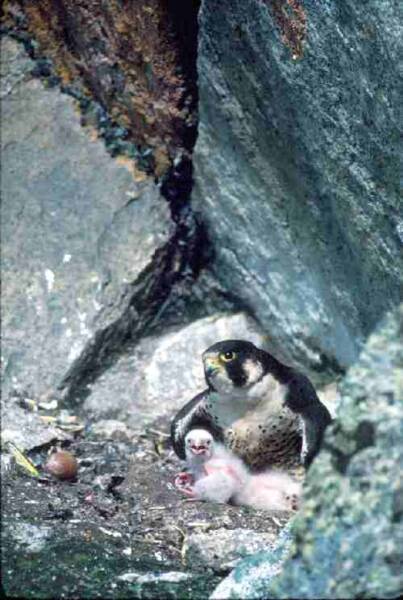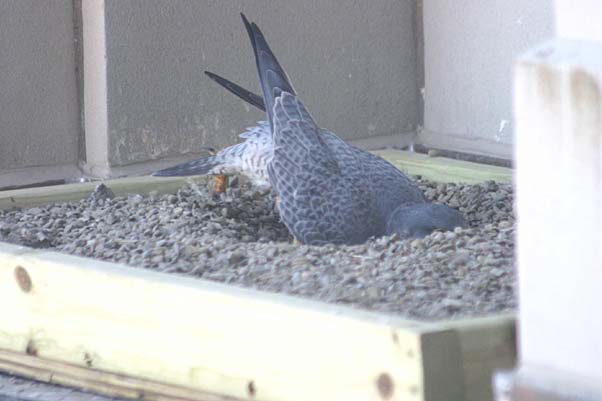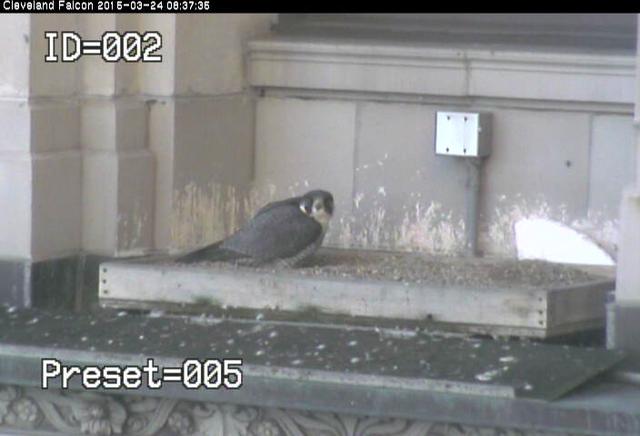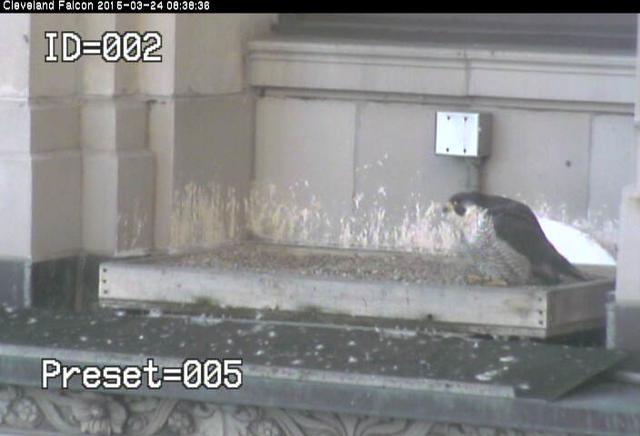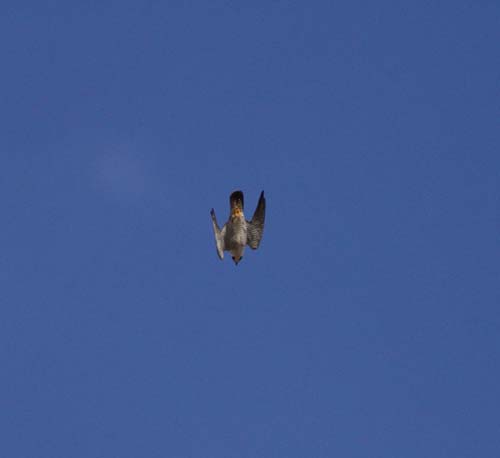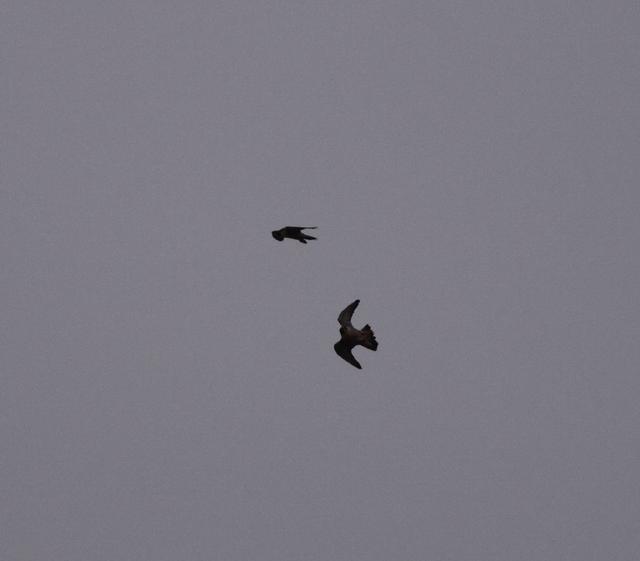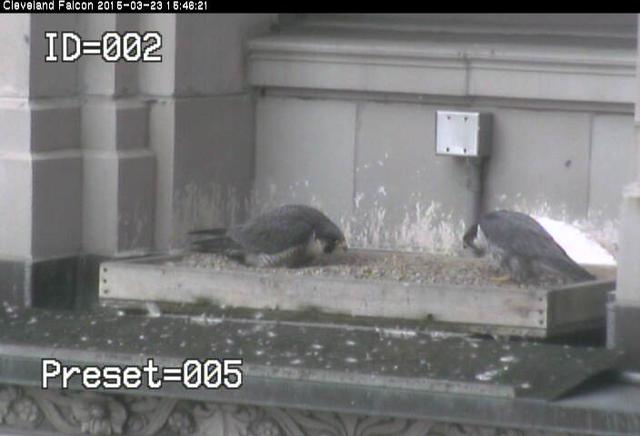FALCON FLASH
Dateline: Cleveland, Ohio
March 24, 2015
Click here to read what happened earlier
Here video of Boomer working on his scrape:
As you watch the FalconCam archives, Mrs. Saladin tells us to look for the following: “Newton will start acting sluggish and spending more time at the nest site, likely perched on the tray waiting for Boomer and/or in the scrape. You may see her with her eyelids closed more often as she is perched and moves less. She may be seen pebble picking and shuffling in to enlarge the scrape and you will continue to see Boomer and Newton doing nest displays. The tiercel (male) shows off and straightens the nest to her as part of these displays and she will eventually choose where she wants to settle in to lay her first egg. You will also see him bringing her prey more often, but she will leave the tray to get the prey from him (either at the tray, on the ledge, or out of view) so that she can take the prey to eat it elsewhere. Peregrines don't typically eat at the nest itself, as this could bring odors and/or draw in scavengers, so unless there's just a piece to finish off quickly they will take it out. Even after there are young to feed they either polish off the leftovers or take them out of the nest. You will also see Newton begin to look "puffy" underneath as the egg forms and she will perch with her tail more horizontal”. What do you think?
Every year during courtship, the male must prove his worth (even if it is the same mate from year to year). This includes courtship behavior in the nestbox as well as flying, hunting, and eating together. “Courtship feeding” is where the male catches prey and presents it to the female to prove that he will be a good provider. It also gives the female the extra nutritional boost she needs to lay healthy eggs. Just before she lays her eggs, she becomes too heavy to hunt on her own.
Boomer has been showing off his flying abilities for Newton because peregrine falcons usually catch their prey (other birds) while flying. In the following picture Boomer performs a dive-down flight called a “stoop” as he draws his wings in so he is shaped like a bullet. It is in the stoop that peregrines achieve their highest speeds, which can reach 200 miles per hour or more.
Newton and Boomer, like many other modern peregrine couples, nest on a skyscraper. However, throughout most of their natural history, peregrine falcons have nested on high, remote cliff ledges that are difficult to reach. The nestsite or "eyrie" (also spelled "aerie") really is not a nest but a shallow depression, or "scrape," in the rocks and soil. Peregrines like to nest in the same place year after year, and there are cliffs in England where peregrines have nested for over 700 years. The following photo from the U.S. Fish and Wildlife Service shows what a peregrine nestsite looks like on a rocky cliff.
As humans began to build skyscrapers in the 20th century, peregrines adapted to the cliff-like buildings and found cities to their liking. At first, peregrines would lay their eggs on a skyscraper ledge and the eggs would often roll off the building during bad weather. Humans have helped nesting peregrines in cities by building nestboxes to avoid this problem. If you have been watching the FalconCam, you may have noticed Boomer and SW scrape an indentation in their nestbox gravel just as they would on a rocky cliff in the wild. In the following picture you can see a male making a scrape in the nestbox gravel.
Looking through the FalconCam archives at http://www.falconcam-cmnh.org/news.php we can see that Newton and Boomer are spending more time at the nestbox. You can click on “Archives” to see one FalconCam picture per minute and count to see what fraction or percent of the time they are in the nest per hour. You can keep a record of their daily activities to see how things change during the nesting season. Nest monitor Mrs. Saladin observes, “they are obviously progressing toward nesting, but I'm not going to suggest that I can say exactly how soon before Newton lays her first egg.…My thought is that she is still choosing between the two scrapes”. Will it be the left scrape?
Or the right scrape?
Keep your eyes and browser set to: http://www.falconcam-cmnh.org/news.php
We are still waiting to see if Newton will lay eggs, but there are eggs at other nests already. Although the peregrine falcon was extinct east of the Mississippi River 50 years ago, this endangered species has recovered from near extinction and is now present in states throughout the U.S. and Canada. Why don’t you look for a peregrine falcon nest in your area to monitor?
Our thanks to the Cleveland Museum of Natural History for sponsoring the FalconCams and for the stills. Photo of a peregrine nestsite on a rocky cliff is from the U.S. Fish and Wildlife Service. Photo of a male working on his scrape is courtesy of former volunteer peregrine nest monitor Scott Wright. Thanks to volunteers Mr. and Mrs. Saladin for the photos of courtship flight and Boomer in a stoop and for their commentary.
Scott Wright, former peregrine falcon nest monitor at this site for 20 years, describes courtship flight: “The male peregrine falcon must showcase his flying ability with stunning displays. Boomer will do a dance in the sky by making long soaring, diving, and gliding displays with tail feathers and wingtip feathers wide open. He will pass close by his mate with his tail feathers all displayed and stretched out, and he and his mate will vocalize to each other. This will continue for some time, and on warmer days with higher winds, the couple will take to the air and together fly a dance across the sky”.
Click here to read what happened next

